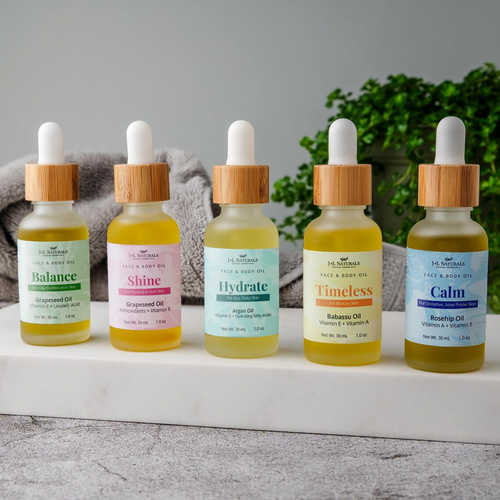FREE US SHIPPING WHEN YOU SPEND $35+
Toxic Ingredients in Skincare: 10 Chemicals to Avoid (and What to Swap Instead)


The beauty and skincare industry is ever evolving. But before you get too excited over that new deodorant, shampoo, or perfume, know that not everything is safe. Unfortunately, many products these days contain toxic ingredients that can wreak havoc on your skin, health, and the planet. In fact, the EU has banned almost 1,400 ingredients — a stark contrast to the U.S., which has banned only 11 ingredients. As consumers, it’s important to be aware of what you’re using on your body. Here are 10 toxic ingredients in skincare to watch out for.
Toxic ingredients in skincare to avoid
Parabens
One of the most common skincare ingredients, parabens are a kind of preservative used to extend a product’s shelf life. Studies have found parabens to be endocrine disruptors, which may increase the risk of breast cancer and other health problems.

Non toxic ingredients swap: Look for products with organic preservatives like benzoic acid or dehydroacetic acid, which are derived from natural sources and have been shown to be safe and effective in preserving skincare products.
Phthalates
Phthalates are chemicals used to soften plastics and are often found in skincare products as a fragrance. They are also used as gelling agents in certain shampoos and grooming products, to allow formulato stick to skin. They have been linked to endocrine disruption, reproductive problems, and other health issues.

Non toxic ingredients swap: Instead of synthetic fragrances, opt for products with essential oils, which are derived from plants and are a natural, safe alternative.
Sulfates
Sulfates are a kind of surfactant that makes formulas lather up. It’s one of the most common toxic ingredients in hair products like shampoo. While they seem harmless, they can strip skin of its natural oils and lead to excessive dryness and irritation.

Non toxic ingredients swap: Use gentler surfactants like coco-glucoside or lauryl glucoside. Not only are they natural, they’re also less likely to cause irritation or dryness.
Synthetic fragrances
Yet another ingredient that sounds harmless, synthetic fragrances are perhaps one of the sneakiest toxins in your products. Because when a label simply states “parfum” or “fragrance,” it’s often used as a catch-all term for several chemicals that brands don’t disclose. As a result, it’s all the more difficult to detect what may irritate your skin or cause health problems.

Non toxic ingredients swap: Go for products with essential oils. These smell just as good (if not even better), and are a safe alternative. Just be sure to check if you’re sensitive to any oils!
Mineral Oil
Mineral oil is a by-product of petroleum and is often added as a moisturizer in skin care products. While not exactly a toxin, it can be potentially carcinogenic if the petroleum used is not highly refined, thus increasing the risk of cancer. Plus, mineral oil can be pore-clogging and cause breakouts.

Non toxic ingredients swap: Seek natural oils like jojoba, argan, or almond oil, which come from plants and are all moisturizing.
Silicones
Silicones are a synthetic polymer used in skincare products to create a smooth, silky texture. They’re quite hard to remove from the skin, which makes it highly likely to clog pores and cause breakouts.

Non toxic ingredients swap: Opt for natural ingredients like aloe vera or plant-based glycerin!
Talc
Often used as a smoothing agent in some make-up, talc or talcum powder is generally safe. However, it is easily contaminated by asbestos, which is known to cause serious diseases like asbestosis, mesothelioma and lung cancer.

Non toxic ingredients swap: Cornstarch and arrowroot are both terrific, safe ingredients that work similarly to talc.
Formaldehyde
Formaldehyde is another chemical that’s often used as a preservative. Despite being notoriously known for its carcinogenic properties, it’s surprisingly still found in products like nail polish, eyelash glue, and hair straighteners. It has been linked to respiratory problems and even cancer.

Non toxic ingredients swap: Choose products with natural preservatives like benzoic acid or dehydroacetic acid.
Alcohol
At the time of COVID, hygiene is critical. So you might be wondering, what’s alcohol doing on a toxic ingredients list? Well, it’s not exactly toxic, and it’s often used as a solvent or astringent. But if your skin is sensitive, excessive use of alcohol can zap your skin dry and cause irritation.

Non toxic ingredients swap: Use natural astringents like witch hazel or rosewater instead.
Oxybenzone
A common ingredient in sunscreen, oxybenzone is used to absorb UVB and UVA rays and protect skin from sun damage. However, this toxin does more harm than good, as it can reportedly disrupt hormones, and cause coral bleaching when used in the ocean. Because of this, Hawaii has even banned all sunscreens with oxybenzone, in an effort to protect our marine life.
Non toxic ingredients swap: For safe, harmless sun protection, opt for zinc oxide-based SPF instead.
Indeed, learning how to check toxic ingredients is an integral skill in this day and age. Yes, finding the right skincare products can feel like a gamble — but it doesn’t have to be! Now that you know some of the most common toxic ingredients in cosmetics and skin care products, it’s your duty as a consumer to sift through your labels thoroughly and diligently.

At J&L Naturals, you’ll never have to second-guess what you put on your skin. Our clean beauty products use only the most natural, ethically sourced ingredients that are good for you, and even better for the planet. Living safely and sustainably shouldn’t have to be a challenge.
Shop clean beauty skincare now on jnlnaturals.com.
##

